Can I Upload a Wordpress Site Someone Built for Me to 3dcart
How To Move Your WordPress Website From localhost To Live Server
Last updated on:
A virtual web server installed on your computer (or local server) allows you to build and customize a WordPress website with ease and speed. Since every edit requires saving and refreshing, developing a WordPress site on a live server can easily plough into a nightmare given the limitations of bandwidth and Internet traffic.
For this reason, almost developers rightly choose to do all the nitty-gritty of WordPress development on a local server and later upload the finished website to the alive server. Similarly, hereafter updates to the website are done and tested locally before being uploaded to the alive environment.
In this post, I'll be going through the process of moving a WordPress website from a local server to a alive server. This process allows yous to safely move all of your site'due south content (images, posts, and pages) besides as themes and plugins from a directory on your calculator to your host'due south production server. Obviously, there are a couple of handy plugins that can make this process a breeze, merely information technology's always advantageous to learn the manual process.
Prerequisites
In this tutorial, I'll assume that you already have met a few prerequisites. These are just a few simple requirements that you'll need before you can get started.
1. Local WordPress Installation
You should have a WordPress website running on your computer. To larn more about setting up your own localhost environment checkout our guides on how to install WordPress locally, or checkout Local past Flywheel.
2. Hosting Programme
You'll also demand an active hosting plan that offers PHP and MySQL support. Fortunately, about hosting providers support PHP and MySQL. Better yet, many providers offering one-click install scripts for WordPress and then you lot don't have to become through the transmission setup.
We of course recommend WP Engine managed WordPress hosting – information technology'south how we power all of our websites and live theme demos. Plus, WP Engine makes managing your sites easy thanks to their intuitive admin panel. Plans offset at $29 per calendar month for one installation (simply you tin get 2 months costless on annual plans when yous use our link). If you're not ready for that cost tag, you can find a smashing starter shared hosting programme for around $3 per month from companies such equally Bluehost or SiteGround.
iii. SFTP Access
And finally, you should have SFTP access to your hosting account forth with a client program such as FileZilla. Yous'll be using it to upload the files to your host. Alternatively, you can use the File Manager option in cPanel but unlike SFTP, cPanel doesn't provide a view of your local directory structure. Okay, with all of that in place, nosotros should be set up to become.
Method 1: Consign & Import Content Using Cadre WordPress Features
A quick and easy mode to move a WordPress site from local server to a production environment is by using the built-in export tool in WordPress. This method assumes that WordPress is already installed and setup on your live hosting account and that there is no content on your live website. This is very of import every bit the WordPress import feature will not override existing content, it will just add to it. If y'all do have old content you can always utilise our guide to reset your WordPress website so y'all have a make clean installation to piece of work with.
Okay – to get started moving your website get to your locally installed WordPress dashboard and gyre downwardly to Tools. Select Export and check the "All content" radial button.
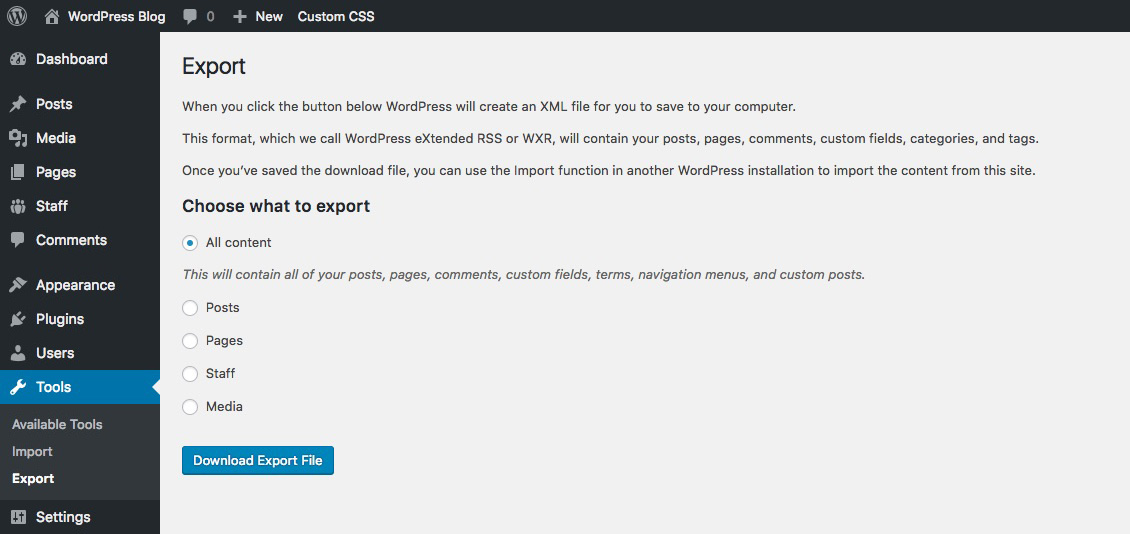
This will download an XML file to your computer. The file will incorporate all the details well-nigh your site's content (unless you selected a atypical content download option, such as only your posts, pages, a custom postal service type or your media).
Now login to your alive WordPress site, then activate the theme and plugins you used on the local server. Once that's done navigate toTools > Import.
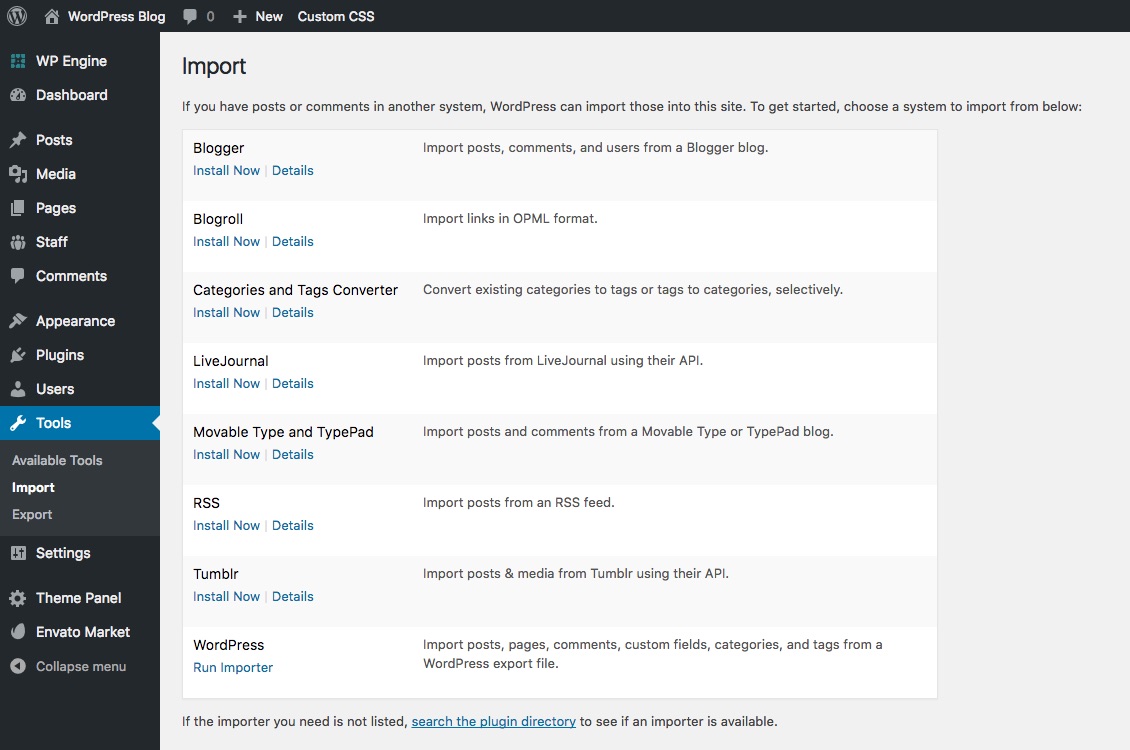
If you're prompted to install the WordPress import plugin, exercise and then and then activate it. Finally, use the plugin to import the .xml file y'all exported from your localhost. To do this commencement click on the Run Importer options under the WordPress heading (Note: you tin can also use the importer feature to move content from other sources such every bit Blogger, Tumblr, etc).
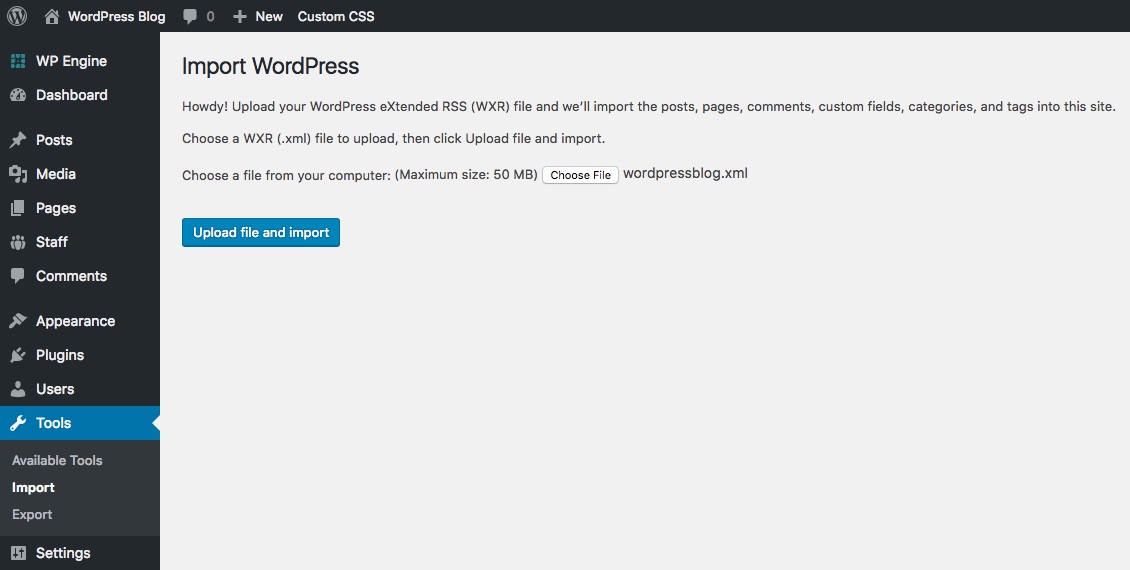
Next utilize the Choose File option to select your XML file then click to upload and import. At present simply await for your content to import. How long y'all wait will depend on how much content you import and your hosting plan.
This method will move your posts, pages, media and menus to your live site. You will of course have to set your menu locations and re-add together your widgets, only considering that everything else is moved over for you, this is a peachy option if you don't desire to install whatsoever extra plugins or process the move manually.
Method 2: Use a Plugin to Move Your WordPress Website
If you lot want a seamless transfer of your website it might be all-time to consider a plugin. A quick Google search will turn upwardly tons o free and premium options, but here are our three favorites (plus a quick explanation on how to utilize them to migrate your website).
DesktopServer
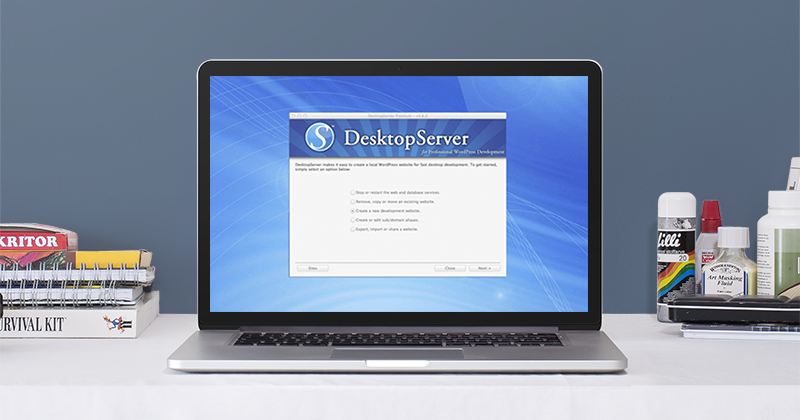
DesktopServer is a premium software your can apply to install WordPress locally on your computer (Mac or PC). It makes it easy to setup a virtual host, indistinguishable test sites, create a local multi-site, archive sites and more. But i of the all-time features of DesktopServer is that you tin easily migrate your local site to your dear server with their complimentary DesktopServer plugin.
Simply install the plugin, export your site from your local DesktopServer setup (beingness sure to select the "Fetch live hosting server details" selection) and import via the plugin. Voila! Merely you can visit their online docs to encounter more than guides on how to deploy DesktopServer to your live server.
Duplicator

Duplicator is an awesome freemium plugin your can apply to manage your own site backups and migrations (and 1 of the most popluar options). With the Duplicator free plugin your can easily create your own on demand backups, design site bundles (a package of content, theme and plugins to reuse on client sites) and easily move your website from local to alive (simply install the plugin locally to package it, and then install on your live site using the same plugin).
Alternatively, if you bound for Duplicator Pro you tin utilize premium features for scheduled backups, synced storage (Amazon, Dropbox, Google Drive etc), multisite compatibility, cPanel API, email notification, pro back up and more. One year costs less than a pair of Nike trainers, and knowing your website is condom and secure is more worth information technology.
BackupBuddy
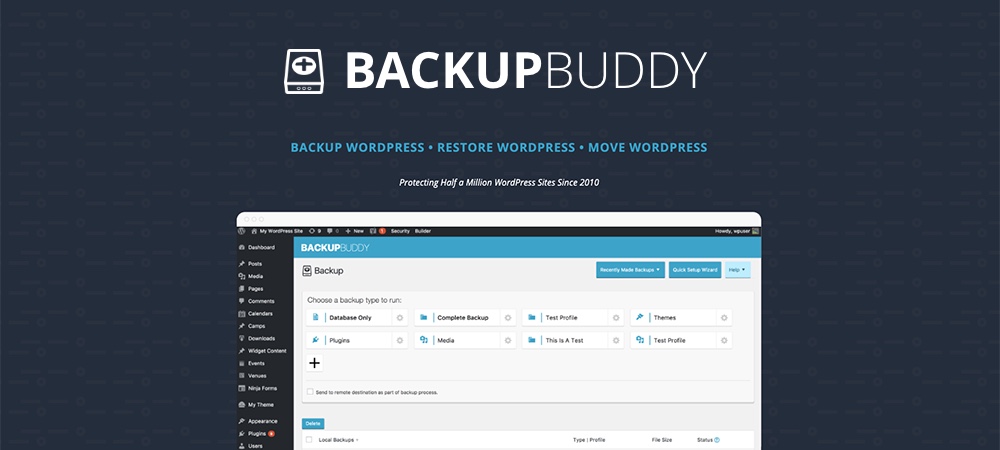
Another fantastic solution is BackupBuddy by iThemes. This lovely plugin is the premier solution to manage your own website backups. With it yous can create total website backups (databases and all), schedule regular backups, shop your own copies (locally or via BackupBuddy Stash) and fifty-fifty restore your website with ImportBuddy.
Only did you know that you can also utilize BackupBuddy to motion your local site to your live one? You lot can use BackupBuddy's built-in migration features to movement your website from estimator to net (or from host to host). The plugin handles domain changes, automatically replaces your URLs and more all to seamlessly transition your website for your large debut.
Transferito
Lastly, another solid free pick is Transferito. This easy site transfer plugin supports server-to-server equally well every bit local-to-server (and visa versa) transfers. So whether you lot desire to motion a copy of your site offline for testing, or move pattern changes dorsum to your live site you tin can.
Method 3: Manually Transfer Files From Local to Live Server
Your terminal option is to manually move your website files. This will crave server access. Essentially, the process entails downloading the database file from the local installation, editing it for the right paths before importing it to a new database on the server, and finally uploading all contents of the local WordPress installation.
Export Your Database File
To start, burn down upwards your local server and navigate to phpMyAdmin –just type localhost/phpmyadmin into your web browser. In this example I'g using XAMPP and here is what my phpMyAdmin interface looks like:
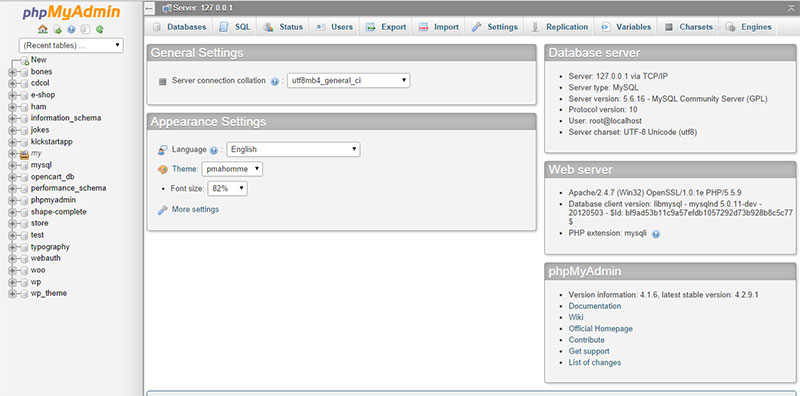
The panel on the left is where all databases are listed. Select the database for your local WordPress site and click on Export at the peak of the phpMyAdmin window. The "Quick" export method is selected past default. Exit information technology intact and click Become.
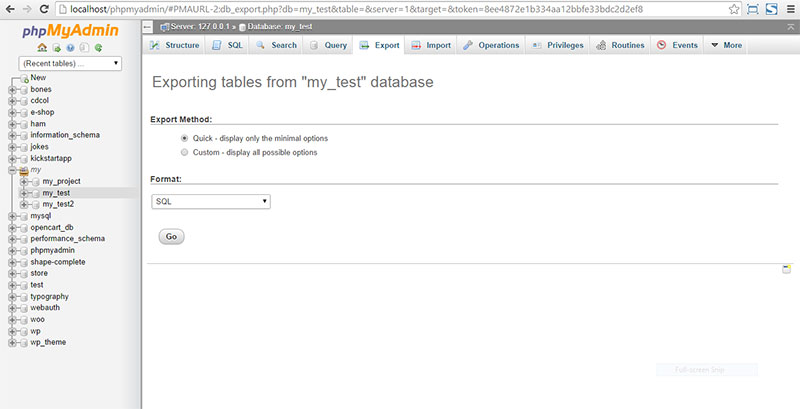
A SQL file (such as my_test.sql) will exist exported to the downloads folder on your computer.
Modify File Paths
When you build your WordPress website locally from the ground upward, keep in mind that all your URLs volition exist absolute paths. In other words, all links to your content files (posts, images, postal service types) volition start with https://localhost/ . You have to alter this link structure for your live installation or your content volition not display properly afterward uploading the database file.
To do that, use a code editor to perform a "find and replace" on the database file you but exported. I'm using Notepad++ to search and replace for "https://localhost/my_test" and replace it with my live URL. I just created a "my_test" folder at the root folder for my domain. If you lot are going to install straight at the root, you don't need to create any folder, so your replacement URL should but exist https://www.yourdomainname.com. You will be uploading your local WordPress folders to public_html (the root of your hosting business relationship).
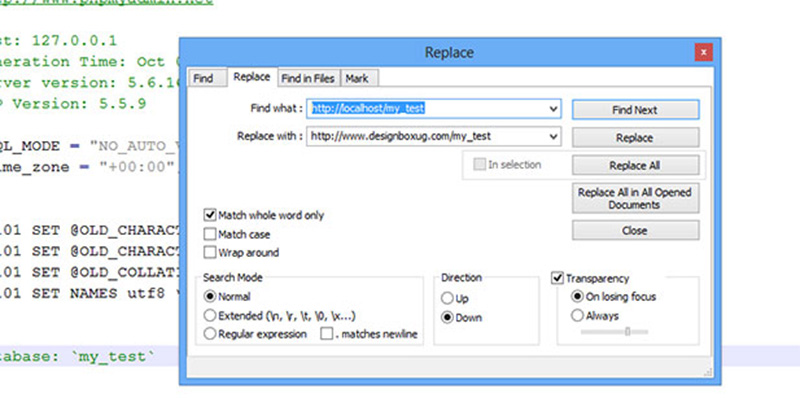
Once you lot're done replacing the URLs, salve and close.
Create New Database on Your Hosting Business relationship
At present yous're done with the main part on the local server. Information technology's time to setup the alive environment and finally get the files uploaded so that your website tin get alive. How y'all setup a new database for your WordPress site will depend on your hosting.,
If your plan uses cPanel (like Bluehost or HostGator) open information technology upwards from your hosting account and scan to MySQL Databases.
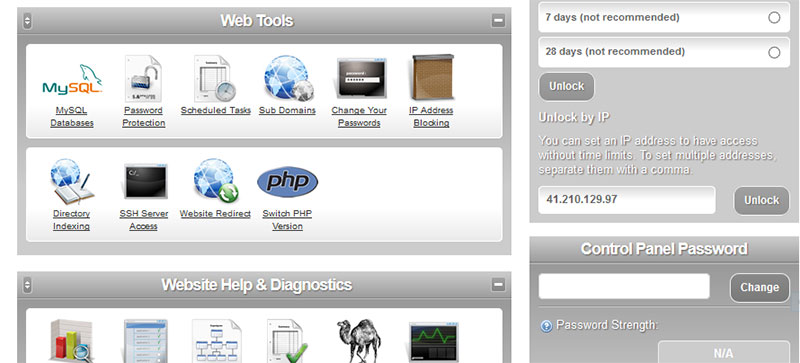
When you select MySQL Databases, you volition be prompted to enter a username and password. This is the new user business relationship that volition exist associated with the new database for your website. Note the personal details like your username and password because you'll need them when configuring the database file in WordPress. The newly created database will have the same proper name as the username you chose.
If you're using a managed hosting business relationship you may not have cPanel. For case, with WP Engine you can create a new installation on your plan simply past logging into your account and clicking theAdd together Install link.

Next fill out the required information (which by the way, you can set this up equally a staging site if you don't have a domain ready just still).
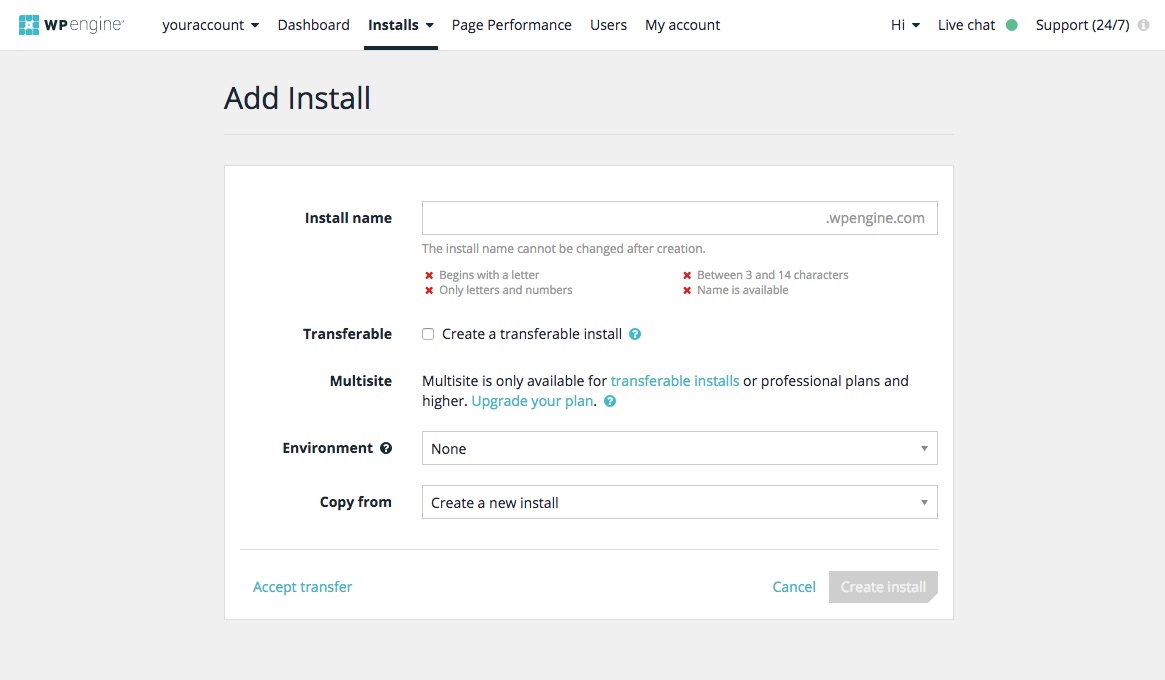
That's it! Your new site (and database) is ready.
Upload Database File into New Database
Now that you have a new (empty) database on the alive server, it'south time to upload your database file saved on your computer. Browse to the phpMyAdmin interface of your host and select Import. Browse and choose the SQL database file you exported from your website on the local server.
If your host doesn't accept phpMyAdmin, employ the Database Restore selection in MySQL Databases. It does the aforementioned matter—allows y'all to scan and select a SQL file.
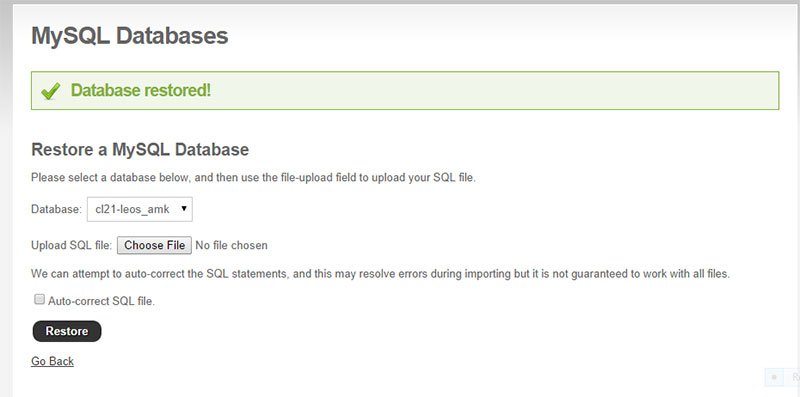
I used the restore option to import my database file. Remember, this is a crucial stride because information technology allows y'all to restore your website exactly as it was on the local installation. Now all that is left is to edit the wp-config.php file, upload website files, and ready the permalinks and nosotros'll be up and running.
Fix wp-config.php File
Open the wp-config.php file in your lawmaking editor (scan to your local WordPress installation folder). Here are the only details you need to change:
- define('DB_NAME', 'your_database_name');
- define('DB_USER', 'your_database_user');
- define('DB_PASSWORD', 'your_database_password');
- ascertain('DB_HOST', 'localhost');
Just make full in the settings you defined while creating the database on your alive server in Step three. For the host proper name, fill up in the server IP address or get out it as localhost if your host explicitly says then. I'll exit mine equally localhost every bit information technology'south clearly stated hither: "To connect to this database in a script running on your web server you should use "localhost" every bit the hostname."When you're done editing the settings, save and close the file. Don't alter anything else.
Note: Brand sure to save a copy of your old values, only in case anything goes wrong you tin can always revert back.
Uploading Website Files
It's now time to motility the actual WordPress website files equally we've setup everything on the alive server. Fire upwards your SFTP client and connect to your hosting account using your SFTP connectedness details. You can get them from your host if you don't have them already. For some hosting providers, the SFTP logins are the aforementioned as the cPanel details.
In one case you're connected, browse to the public_html or world wide web folder (or a folder at the root where you want to install your WordPress website) and copy all files from your WordPress installation folder on the local server to this directory on the live server.
Modify Permalinks
The concluding pace is to modify the permalink structure of your new website to match that of your onetime site on the local server. To do this, go to the admin dashboard of your new website and scan to Settings > Permalinks. Select the construction you lot used for your local installation and save. Your WordPress website should at present be live.
Determination
By now you should have proper insight on what happens when moving a local WordPress installation to a live server. WordPress allows for a lot of flexibility and ease of use. Developing on localhost allows for unlimited tweaks and customizations because yous tin can afford to brand mistakes there that you cannot afford to make in a live, product surroundings.
What's your best method for uploading a WordPress website from local host to alive server? If you've gone through this process earlier, what was your experience like? Delight share your thoughts in the comments!
Source: https://www.wpexplorer.com/wordpress-local-to-live/

0 Response to "Can I Upload a Wordpress Site Someone Built for Me to 3dcart"
Post a Comment